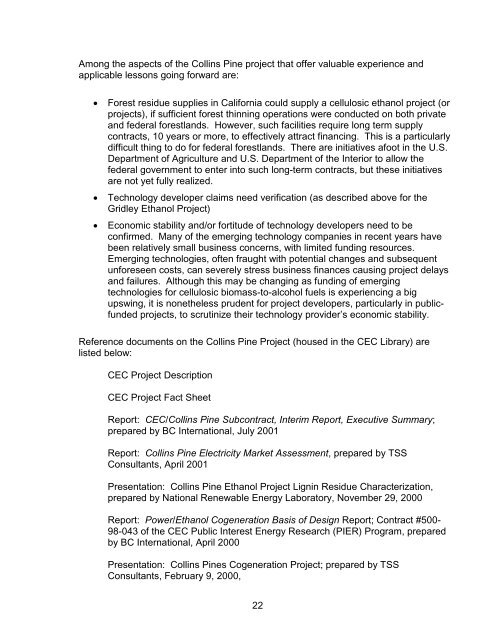Assessment of Conversion Technologies for Bioalcohol Fuel ...
Assessment of Conversion Technologies for Bioalcohol Fuel ...
Assessment of Conversion Technologies for Bioalcohol Fuel ...
You also want an ePaper? Increase the reach of your titles
YUMPU automatically turns print PDFs into web optimized ePapers that Google loves.
Among the aspects <strong>of</strong> the Collins Pine project that <strong>of</strong>fer valuable experience and<br />
applicable lessons going <strong>for</strong>ward are:<br />
Forest residue supplies in Cali<strong>for</strong>nia could supply a cellulosic ethanol project (or<br />
projects), if sufficient <strong>for</strong>est thinning operations were conducted on both private<br />
and federal <strong>for</strong>estlands. However, such facilities require long term supply<br />
contracts, 10 years or more, to effectively attract financing. This is a particularly<br />
difficult thing to do <strong>for</strong> federal <strong>for</strong>estlands. There are initiatives afoot in the U.S.<br />
Department <strong>of</strong> Agriculture and U.S. Department <strong>of</strong> the Interior to allow the<br />
federal government to enter into such long-term contracts, but these initiatives<br />
are not yet fully realized.<br />
Technology developer claims need verification (as described above <strong>for</strong> the<br />
Gridley Ethanol Project)<br />
Economic stability and/or <strong>for</strong>titude <strong>of</strong> technology developers need to be<br />
confirmed. Many <strong>of</strong> the emerging technology companies in recent years have<br />
been relatively small business concerns, with limited funding resources.<br />
Emerging technologies, <strong>of</strong>ten fraught with potential changes and subsequent<br />
un<strong>for</strong>eseen costs, can severely stress business finances causing project delays<br />
and failures. Although this may be changing as funding <strong>of</strong> emerging<br />
technologies <strong>for</strong> cellulosic biomass-to-alcohol fuels is experiencing a big<br />
upswing, it is nonetheless prudent <strong>for</strong> project developers, particularly in publicfunded<br />
projects, to scrutinize their technologyprovider’seconomic stability.<br />
Reference documents on the Collins Pine Project (housed in the CEC Library) are<br />
listed below:<br />
CEC Project Description<br />
CEC Project Fact Sheet<br />
Report: CEC/Collins Pine Subcontract, Interim Report, Executive Summary;<br />
prepared by BC International, July 2001<br />
Report: Collins Pine Electricity Market <strong>Assessment</strong>, prepared by TSS<br />
Consultants, April 2001<br />
Presentation: Collins Pine Ethanol Project Lignin Residue Characterization,<br />
prepared by National Renewable Energy Laboratory, November 29, 2000<br />
Report: Power/Ethanol Cogeneration Basis <strong>of</strong> Design Report; Contract #500-<br />
98-043 <strong>of</strong> the CEC Public Interest Energy Research (PIER) Program, prepared<br />
by BC International, April 2000<br />
Presentation: Collins Pines Cogeneration Project; prepared by TSS<br />
Consultants, February 9, 2000,<br />
22
















